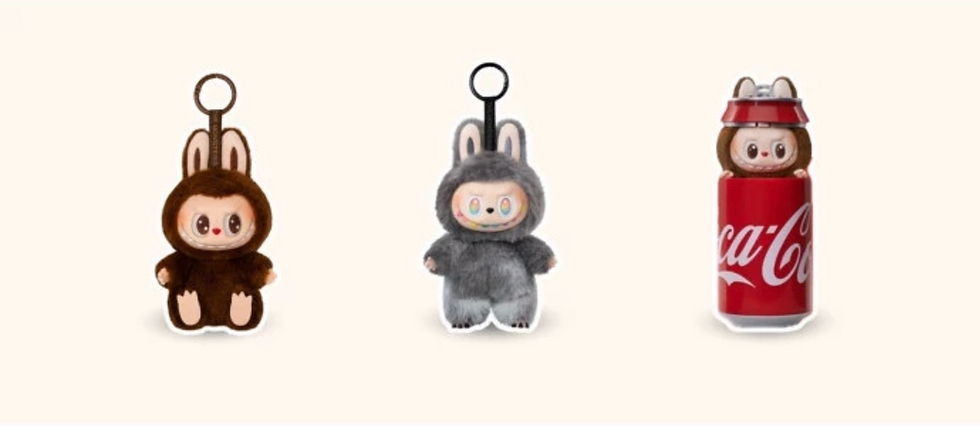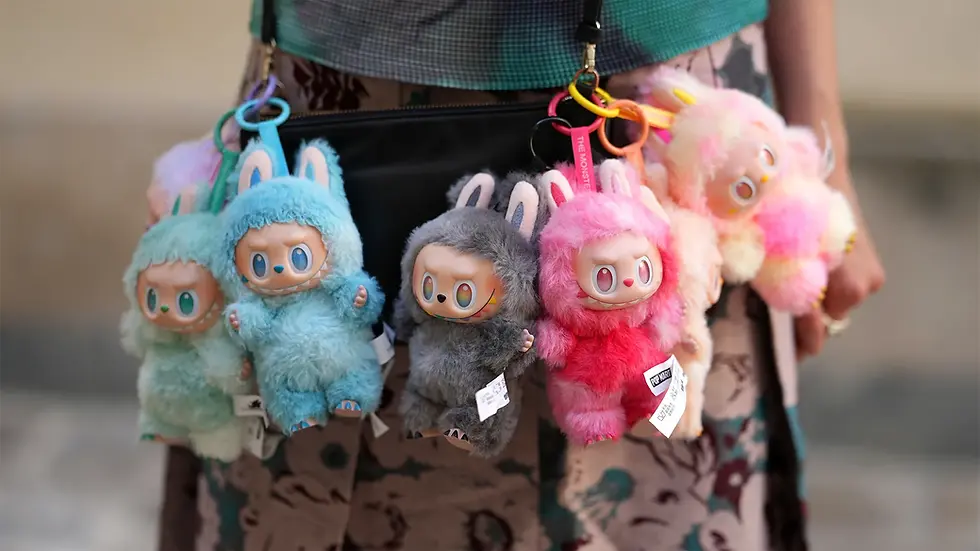Labubu: The Mischievous Elf That Conquered Fashion, Finance and Fandom
- warwickluxretail
- Aug 18
- 5 min read
In the time it takes to post a TikTok, a $20 Labubu can turn into a $10,000 auction lot. Born from Hong Kong art, raised on Pop Mart’s scarcity playbook, and adopted by the fashion world, this mischievous elf is rewriting luxury’s rules—from vending machine to runway.
By Ridhi Sofat
August 2025
When a toothy, wide-eyed plush elf named Labubu started appearing in Marc Jacobs’ handbag, in frenzied TikTok unboxings, and sparking five-figure bidding wars on eBay, it was clear that this wasn’t just another passing toy fad. Born in the sketchbook of Hong Kong artist Kasing Lung and scaled into a global phenomenon by Beijing’s Pop Mart, Labubu has crossed the lines between art object, fashion accessory, cultural status symbol, and speculative investment.

This is more than just a collectable craze. It’s a multi-billion-dollar masterclass in cultural momentum - where scarcity fuels desire, branding becomes global currency, and a plush elf proves that intellectual property can be as powerful as any fashion house logo.

Origins: From Artist’s Oddball Sketch to Global Brand Ecosystem

Labubu began in 2015 as part of The Monsters Trilogy, Lung’s gothic-meets-cute picture book series inspired by Nordic folklore. Initially distributed through niche art toy maker How2Work, the character’s big break came in 2019 when Pop Mark licensed the intellectual property and set it on a new trajectory. Pop Mart - China’s collectable toy powerhouse - reimagined Labubu through its blind box retail model: sealed packaging where buyers don’t know which variant they will receive. This was more than novelty packaging. It was gamification at scale - combining surprise, scarcity and social bragging rights into an addictive purchasing loop.

The result was a character that kept its artistic integrity while becoming a scalable global product line - one that could be sold everywhere from vending machines in Shanghai to pop-ups in San Francisco.
The Mechanics of Obsession: Inside the Pop Mart Playbook
Labubu’s rise was anything but accidental. It was the outcome of a meticulously engineered

strategy that borrows heavily from the fashion industry combined with consumer psychology to fuel what is now a $43 billion brand story. Pop Mart has mastered the art of turning buying to an addictive ritual, using four core levers:
Scarcity-driven FOMO - “Secret” Labubus, with odds of 1-in-72, can sell for up to 500 times their $20-$30 retail price

The Three Most Wanted Secret Labubu Cross-category collaborations with Vans, Coca-Cola, Sacai and Naruto - all of which pull in different subcultures and keep the product relevant across demographics
Community-driven amplification - TikTok unboxings, Instagram treasure hunts and Discord trading groups have turned customers into viral marketing teams
Controlled supply shocks - Pausing sales in regions like the UK intensifies desire and resale frenzy.

Queues for Labubus in Amsterdam, Singapore and the US
The financial results speak for themselves. In 2024 alone, Labubu generated €796 million ($870 million) in revenue, accounting for 23% of Pop Mart’s total sales. Plush toy sales surged by 1,289% year-on-year, helping push Pop Mart’s market cap to $43 billion — surpassing Hasbro and Mattel.
The Business Model

If the Playbook explains how Pop Mart creates demand, the Business Model explains how it monetises it. Labubu’s commercial engine reads like a luxury fashion case study, but runs on a far faster, leaner cycle.The blind box system acts as the equivalent of the seasonal drop, fuelling urgency and repeat purchasing. Limited edition collaborations mirror capsule fashion collections, while celebrity integration serves as the modern runway. Crucially, Pop Mart’s production cycle is lightning fast. Where traditional fashion houses operate on months-long timelines, Labubu drops can move from concept to store in weeks, capitalising on viral trends before they fade.

By combining the economics of collectibility with the cultural playbook of luxury, Pop Mart has built a prestige-driven yet mass-accessible product with enviable margins. It’s essentially a Hermès Birkin strategy — but turbocharged with the resale volatility and cultural energy of a sneaker drop
Cultural Crossover: From Toy Shelf to Runway
Labubu has broken free from the “toy” category entirely and has entered the world of cultural status symbols. It has been carried by Marc Jacobs like an accessory, reimagined as the Mona Lisa for a Louvre-exclusive line, and spotted in the hands of Rihanna and Dua Lipa.

This crossover works because Labubu sits comfortably at the intersection of streetwear exclusivity and fine art collectibility - a space where price tags aren’t just tolerated, but are part of the appeal. The character’s quirkiness has also made it a symbol of Asia’s cultural ascent, showing the power of homegrown ideas and products.


The ripple effects are everywhere: edible Labubu-themed pastries in Moscow, tattoos in Bangkok, knockoffs flooding Indian markets. What began as a character is now a meme, a cultural shorthand and a tool of soft power.
Labubu as Asset Class
For a growing number of buyers, Labubu is not just a collectible — it’s an investment. Limited editions and high-profile collaborations now trade at auction prices usually reserved for fine art. A Vans x Labubu Old Skool plush sold for $10,585 after 96 bids; the Three Wise Labubu fetched $28,300 at Sotheby’s; the Sacai x Seventeen x Labubu sold for $31,250; and a life-sized edition topped $150,000.

The appeal for investors is obvious: limited supply, high demand, and a devoted global community. Early editions and major collaborations are likely to retain value, while the broader product line benefits from the halo effect. There appears to be cultural longevity, with the character rooted in an artist-led brand, not a corporate mascot. But the risks mirror past speculative bubbles, from Beanie Babies to sneaker hype. Common editions may never appreciate. Liquidity can be a challenge in niche markets. Counterfeit “Lafufus” are already circulating.

And most critically, the market depends on continued cultural relevance — a factor as volatile as social media itself. Experts see parallels with the Beanie Baby boom-and-bust: early editions retain value, the rest fade.
Why It Matters for the Business of Fashion
Labubu is doing what luxury fashion houses have done for decades - using storytelling, scarcity, and cultural infiltration to transform functional products into symbolic goods. The difference? Pop Mart has collapsed the runway-to-retail timeline. In fashion, trends move seasonally; in the Labubu economy, they move hourly. A collab drop can sell out in minutes, with resale listings appearing before the first customer leaves the store. This could be the next evolution of the luxury playbook: faster cycles than traditional fashion, lower production costs with luxury-level margins, and infinite cross-industry potential — from vending machines to Sotheby’s auctions.

The Bottom Line
Labubu has rewritten the rules of cultural capital. It is, all at once, a status symbol, a financial asset, and a creative export. The question now is whether it will follow the Birkin bag’s path — timeless, scarce, investment-worthy — or repeat the Beanie Baby’s fate of overproduction and collapse. Either way, the next big “it” item in fashion may not come from a Paris runway or a Milan atelier, but from a vending machine in Beijing — grinning mischievously, ready to conquer the worlds of fashion, finance, and fandom.







Comments